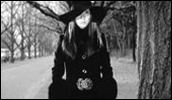Female Convict Scorpion: Jailhouse 41
- Year
- 1972
- Original title
- Joshu Sasori Dai-41 Zakkyobo
- Japanese title
- 女囚さそり 第41雑居房
- Director
- Cast
- Running time
- 89 minutes
- Published
- 22 May 2001



by Jasper Sharp
Debuting in a number of small roles for Nikkatsu under her real name of Masako Ota, the elegant Meiko Kaji first caught the eye of the Japanese public when she took the star role as the leader of a vicious gang of female bikers with five films in the Stray Cat Rock series that ran from 1969 to 1971 (kicking off with Stray Cat Rock: Female Boss / Noraneko Rokku: Onna Bancho, helmed by the director of the flamboyant Black Tight Killers, Yasuharu Hasebe).
The success of these films led to a number of further starring roles - amongst them two films for Joys of Torture director Teruo Ishii, (Ascending Dragon: Gamblers Skin / Nobori Ryu Tekka Hada, 1969 and The Blind Woman's Curse / Kaidan Nobori Ryu, 1970) - before she switched studios when Nikkatsu turned their production exclusively over to their Roman Porno line. Her central role in Toei's series of prison actioners Female Convict Scorpion (Joshu Sasori) as Matsu, better known as Sasori (Scorpion) to her fellow inmates, proved immensely popular and led to one of the most fascinating Japanese serials of the 1970s.
The Golden Decade of Sexploitation saw a plethora of women-in-prison flicks in which the imagined ongoings of bare babes behind bars formed a convenient backdrop into which to slot the requisite number of catfighting, lesbian, torture, and communal shower scenes with films from such diverse sources as Hong Kong (Chin Hung Kuei's Bamboo House of Dolls, 1974), the U.S. (Jonathan Demme's Caged Heat, 1974), the Phillipines (War Victims, 1983), and Europe - Spanish sleazemeister Jess Franco directed no fewer than five for the Swiss producer Erwin C. Dietrich between 1975 and 1977!
Don't be mistaken however, the Female Convict series is worlds apart from these sleazy productions, being both far better made and far less exploitative, and adopting an almost fantastical approach to the material. In fact this film, episode two of the series, spends very little time inside the prison walls at all, instead focusing on the women's escape from their warders through a bizarre succession of surreal encounters.
Based on the popular manga series by Toru Shinohara, director Shunya Ito frames the action of Jailhouse 41 in pure comic strip style. Kaji was apparently unhappy with the original portrayal of the character of Sasori on the page, especially the perpetual stream of obscenities flowing from her mouth, so the script was tailored to allow her to play the role almost silently. The change makes for a surprisingly effective heroine, bringing an exquisite dignity to the character as she tags along aloof from the rest of the group, only entering into the fray when absolutely necessary.
Introduced shackled and bound and bathed in blue light at the bottom of the pit where she has lain for a year, scraping at the ground with a spoon in her mouth before she is hosed down by her wardens and dragged back to rejoin her fellow convicts, Sasori's year in solitary confinement fails to subdue her. Straight away she lunges at the Head Prison Warder's face shattering his spectacles with the sharpened spoon handle, an act which lands her bound to a makeshift crucifix of tree branches surrounded by braying dogs and guards clad in nylon masks as the rest of the rest of female convicts are chained together and put to hard labour. The film really gets underway when the girls break out of the van transferring them to a higher security unit, swathed in black robes as they flee across a village buried under volcanic ash through a string of diverse and increasingly weird episodes.
As night falls in a scene where the wanted women hide out in a deserted village, the whole set appears to peel away against a loud crack of thunder to reveal the only inhabitant, a ghostly woman clutching a knife. Later the convicts are introduced individually in Kabuki style against a plain black backdrop, a male singer crooning in the background revealing their crimes, which are predominantly against the male sex: this is a world where women rule. Sasori's main rival in the group (played by Kayoko Shiraishi) is a snarling caricature of evil, lifting up her smock to display the scars of when she committed infanticide by stabbing at the unborn foetus nestling in her belly after murdering her husband. After fleeing through an autumnal forest of golds and reds, the gang clash against a busload of rowdy tourists - sexist salarymen who come out of the deal rather the worse off for their behaviour.
Kaji's lead as Sasori lasted for the first four films in the series, all directed by Ito save the fourth from the aforementioned Hasebe. After this, former assistant director Yutaka Kohira took over directorial duties for two more entries with new actresses as Sasori before the series trundled out of steam, ending with New Female Convict - Special Cellblock X (Shin Joshu Sasori - Tokushubo X, 1977). In 1991, Evil Dead Trap director Toshiharu Ikeda resurrected the character in Female Convict Scorpion: Death Threat (Joshu Sasori - Satsujin Yokoku). Kaji, in the meantime, went on to star in Lady Snowblood (Shurayukihime) in 1973 and its sequel the following year, Toshiya Fujita's feminisation of the Lone Wolf / Kozure Okami series released by Toho.
Jailhouse 41 may not have much in the way of plot, but there are some truly standout images on display as the potentially banal premise gives rise to an almost hallucinogenic mish-mash of scenes that look like they've been lifted from any number of disparate genres. If you thought you'd witnessed all the action film had to offer, then think again, and be sure to pick up a copy of Jailhouse 41 next time you're out shopping.